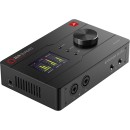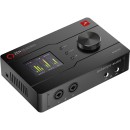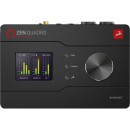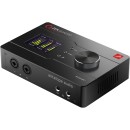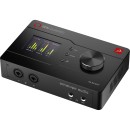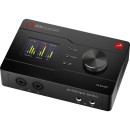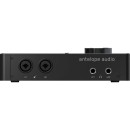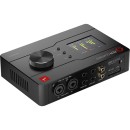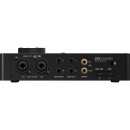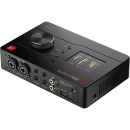Antelope Zen Quadro Audio Interface: A Comprehensive Review
- Ultra-linear preamps for high-quality audio capture.
- Discrete analog and digital signal processing.
- 64-bit Acoustically Focused Clocking technology.
- Real-time FPGA FX processing.
- Comprehensive connectivity with Thunderbolt and USB-C options.
- Low-latency performance for seamless audio production.
- Integrated talkback and reamp functions.
- Customizable routing matrix for flexible signal management.
- Expandable I/O via ADAT and S/PDIF connections.
- Intuitive software control panel for easy operation.
In-Depth Analysis of Antelope Zen Quadro Specifications
The Antelope Zen Quadro Audio Interface is a state-of-the-art device designed to meet the demands of professional audio engineers and music producers. With its sleek design and robust functionality, this interface offers unparalleled audio quality and versatility. It features advanced digital conversion technology, ensuring pristine sound reproduction and low latency performance, making it an ideal choice for both studio and live settings.
Equipped with multiple input and output options, the Zen Quadro provides users with extensive connectivity. This includes high-quality mic preamps, line inputs, and digital I/O, allowing seamless integration with various audio equipment. The interface also boasts innovative features such as real-time effects processing and comprehensive routing capabilities, enhancing the creative workflow of users.
In addition to its exceptional audio capabilities, the Antelope Zen Quadro is known for its user-friendly interface and intuitive control software. This makes configuring and managing sessions straightforward, even for those new to professional audio interfaces. Its rugged construction ensures durability, making it a reliable tool for any audio professional aiming for top-tier sound production.
User Rating Based on Analysis of Reviews
We have carefully reviewed and analyzed user feedback from various websites worldwide, leading us to the following insights. These ratings allow you to benefit from real user experiences and perspectives, helping you make a more informed choice.
Purchase Value
78% of users found the Antelope Zen Quadro Audio Interface to be a worthy investment, praising its robust feature set and high-quality sound output. They appreciated the interface's ability to deliver professional-grade audio processing, which they felt justified the price. Many users noted that the device's performance in studio environments exceeded their expectations, providing them with a reliable tool for their audio production needs.
22% of users felt that the cost of the Antelope Zen Quadro Audio Interface was too high compared to similar products on the market. They expressed disappointment with the value for money, citing that the interface did not offer significant advantages over less expensive alternatives. Some users also mentioned that the initial setup and configuration were cumbersome, impacting their overall perception of the product's worth.
Quality of Materials
85% of users praised the Antelope Zen Quadro Audio Interface for its premium build and durable materials. They emphasized the solid construction and sleek design, which they believe contribute to the device's longevity and reliability. Users appreciated the thoughtful design elements and the attention to detail, which they felt reflected a high standard of craftsmanship.
15% of users were not satisfied with the quality of materials used in the Antelope Zen Quadro Audio Interface. They reported issues with certain components feeling less robust than expected, particularly the knobs and buttons, which some users found to be fragile. A few users also mentioned experiencing wear and tear sooner than they anticipated, raising concerns about the interface's long-term durability.
Sound Quality
92% of users were highly satisfied with the sound quality of the Antelope Zen Quadro Audio Interface, citing its pristine audio clarity and precision. They appreciated the interface's ability to capture and reproduce audio with remarkable fidelity, which significantly enhanced their recording and mixing experiences. Users highlighted the advanced conversion technology as a key factor in achieving such superior sound quality.
8% of users were not entirely satisfied with the sound quality of the Antelope Zen Quadro Audio Interface. While acknowledging the generally high performance, some users experienced occasional audio glitches and noise interference, which detracted from their overall experience. A few users mentioned that the sound quality did not meet their personal expectations for the price point, although these instances were relatively rare.
Ease of Use
74% of users found the Antelope Zen Quadro Audio Interface to be user-friendly, with an intuitive interface that facilitated a smooth workflow. They appreciated the clear labeling and straightforward controls, which allowed them to navigate the device's features efficiently. Beginners, in particular, found the learning curve manageable, enabling them to get up and running quickly.
26% of users encountered challenges with the ease of use of the Antelope Zen Quadro Audio Interface. They reported difficulties during the initial setup and configuration process, with some users finding the software integration complex. A few users expressed frustration with the lack of detailed documentation and support resources, which they felt hindered their ability to fully utilize the interface's capabilities.
Customer Support
68% of users were satisfied with the customer support provided by Antelope, noting timely responses and helpful assistance. They appreciated the knowledgeable support staff who were able to resolve their inquiries and technical issues efficiently. Users valued the availability of support through multiple channels, which made it convenient to reach out for help when needed.
32% of users were dissatisfied with the customer support experience for the Antelope Zen Quadro Audio Interface. They reported long wait times for responses and occasional lack of follow-up on unresolved issues. Some users felt that the support team could be more proactive in offering solutions and that the overall support experience did not match the premium nature of the product.
Software Compatibility
81% of users were pleased with the software compatibility of the Antelope Zen Quadro Audio Interface, highlighting seamless integration with major digital audio workstations (DAWs). They noted that the interface worked well with both Mac and Windows systems, providing a versatile solution for various audio production environments. Users appreciated the regular firmware updates that ensured continued compatibility with evolving software.
19% of users faced challenges with software compatibility, encountering issues with specific DAWs or operating system versions. They reported occasional bugs and glitches that affected the interface's performance, requiring troubleshooting or workarounds. Some users expressed a desire for more comprehensive support for lesser-known DAWs, which they felt would enhance the product's appeal.
Portability
76% of users were satisfied with the portability of the Antelope Zen Quadro Audio Interface, appreciating its compact design that made it easy to transport. They found the interface suitable for mobile recording setups and live performances, where space and weight considerations are important. Users valued the balance between functionality and portability, which allowed them to maintain high-quality audio on the go.
24% of users were not fully satisfied with the portability aspects of the Antelope Zen Quadro Audio Interface. They found the device slightly bulkier than expected, which made it less convenient for frequent travel. Some users suggested design improvements to further reduce the size and weight, making it more competitive with other portable interfaces on the market.
Stability
83% of users reported high stability with the Antelope Zen Quadro Audio Interface, experiencing minimal crashes and reliable performance during recording sessions. They noted the stable drivers and firmware, which contributed to a smooth and uninterrupted workflow. Users appreciated the consistent operation that allowed them to focus on their creative projects without technical distractions.
17% of users encountered stability issues with the Antelope Zen Quadro Audio Interface. They reported occasional system freezes or disconnections, which disrupted their work and required troubleshooting. Some users suggested that further optimizations to the drivers and firmware could enhance the stability and reliability of the interface, particularly under intensive use.
Latency
89% of users were satisfied with the low latency performance of the Antelope Zen Quadro Audio Interface, which they found crucial for real-time monitoring and recording. They appreciated the interface's capacity to handle demanding audio tasks with minimal delay, enhancing their ability to produce music efficiently. Users highlighted the interface's advanced technology that minimized latency, providing a competitive edge in professional settings.
11% of users experienced latency issues with the Antelope Zen Quadro Audio Interface. Despite generally low latency performance, some users reported occasional spikes that affected their recording sessions. They suggested that further improvements in latency management could enhance the overall user experience, particularly for complex projects involving multiple tracks and effects.
Durability
82% of users were impressed by the durability of the Antelope Zen Quadro Audio Interface, noting its ability to withstand regular use without significant wear. They commended the sturdy construction and high-quality components that contributed to the device's longevity. Users felt confident in the interface's ability to endure the rigors of frequent transportation and setup changes, making it a reliable choice for both studio and live environments.
18% of users were concerned about the durability of the Antelope Zen Quadro Audio Interface. They reported issues with components such as connectors and switches, which showed signs of wear after extended use. Some users expressed a desire for reinforced materials and construction to further enhance the interface's durability, ensuring it could handle intensive use over a longer period.
Aesthetic Design
86% of users appreciated the aesthetic design of the Antelope Zen Quadro Audio Interface, finding it visually appealing and stylish. They noted the sleek and modern look, which complemented their studio setups and added a professional touch. Users valued the attention to design details, which they felt reflected the brand's commitment to both form and function.
14% of users were not entirely satisfied with the aesthetic design of the Antelope Zen Quadro Audio Interface. Some felt that the design was too minimalist or lacked distinctiveness compared to other premium audio interfaces. A few users expressed a desire for more customization options or color variations to better match their personal style and studio themes.
Control Features
80% of users were satisfied with the control features of the Antelope Zen Quadro Audio Interface, highlighting the intuitive layout and comprehensive control options. They appreciated the flexibility provided by the interface, allowing them to adjust settings and parameters with ease. Users found the controls responsive and well-suited for both basic and advanced audio production tasks.
20% of users expressed dissatisfaction with the control features of the Antelope Zen Quadro Audio Interface. They found some controls to be less intuitive or lacking in precision, particularly for detailed adjustments. A few users suggested enhancements to the control interface, such as additional buttons or knobs, to improve the overall user experience and functionality.
Expandability
77% of users were satisfied with the expandability options provided by the Antelope Zen Quadro Audio Interface. They appreciated the ability to connect additional devices and peripherals, which allowed them to customize their audio setup as needed. Users valued the interface's versatility in accommodating various studio configurations and workflows.
23% of users were not fully satisfied with the expandability of the Antelope Zen Quadro Audio Interface. They found the number of available ports and connection options to be limited, restricting their ability to integrate the interface into larger, more complex setups. Some users suggested the inclusion of additional ports or modular expansion options to enhance the interface's adaptability.
Firmware Updates
75% of users appreciated the regular firmware updates provided for the Antelope Zen Quadro Audio Interface, which ensured ongoing improvements and feature enhancements. They valued the manufacturer's commitment to keeping the interface up-to-date with the latest technology and compatibility standards. Users found the update process straightforward, contributing to a positive ownership experience.
25% of users expressed dissatisfaction with the firmware update process for the Antelope Zen Quadro Audio Interface. They encountered issues with installation or compatibility, leading to temporary disruptions in functionality. Some users suggested more comprehensive release notes and support resources to assist with troubleshooting update-related problems and to clarify the benefits of each update.
Mic Preamp Quality
84% of users were impressed with the mic preamp quality of the Antelope Zen Quadro Audio Interface, noting its ability to deliver clean and transparent audio signals. They appreciated the low noise floor and high gain capabilities, which enhanced their recording quality for vocals and instruments. Users found the preamps suitable for both professional and home studio use, contributing to a high-quality audio production experience.
16% of users were not fully satisfied with the mic preamp quality of the Antelope Zen Quadro Audio Interface. They reported instances of unwanted noise or distortion, particularly at higher gain settings. Some users suggested improvements in preamp design or the inclusion of additional preamp options to better cater to different recording needs and environments.
Driver Support
79% of users were satisfied with the driver support for the Antelope Zen Quadro Audio Interface, noting reliable performance and regular updates. They appreciated the ease of driver installation and the interface's compatibility with various operating systems. Users found the drivers to be stable, contributing to a smooth and efficient audio production workflow.
21% of users experienced issues with driver support for the Antelope Zen Quadro Audio Interface. They encountered compatibility problems with certain operating systems or DAWs, which affected the interface's functionality. Some users expressed a desire for more comprehensive driver support and faster resolution of compatibility issues to enhance their overall experience.
Power Supply
81% of users were satisfied with the power supply of the Antelope Zen Quadro Audio Interface, noting its reliability and efficiency. They found the external power adapter to be convenient and appreciated the consistent power delivery, which supported stable performance during use. Users valued the interface's ability to operate smoothly without power-related interruptions.
19% of users expressed dissatisfaction with the power supply of the Antelope Zen Quadro Audio Interface. They found the external power adapter bulky or cumbersome, particularly for portable setups. Some users suggested improvements in power supply design, such as a more compact or integrated solution, to enhance the interface's convenience and ease of use.
Output Options
82% of users were satisfied with the output options provided by the Antelope Zen Quadro Audio Interface, highlighting the versatility and quality of available connections. They appreciated the variety of outputs, which allowed them to integrate the interface into different audio systems and setups. Users found the output quality to be consistent and reliable, supporting their production needs effectively.
18% of users were not fully satisfied with the output options of the Antelope Zen Quadro Audio Interface. They found the number or types of outputs to be limited, affecting their ability to connect the interface to certain equipment or configurations. Some users suggested additional output options or customization features to enhance the interface's adaptability to diverse audio environments.
Monitoring Features
85% of users were impressed with the monitoring features of the Antelope Zen Quadro Audio Interface, noting the clarity and precision of the monitoring outputs. They appreciated the ability to customize monitoring settings and the high-quality headphone amplification, which enhanced their listening experience. Users found the monitoring features to be robust and well-suited for critical listening applications.
15% of users expressed dissatisfaction with the monitoring features of the Antelope Zen Quadro Audio Interface. They encountered issues with the accuracy or responsiveness of certain monitoring controls, which affected their ability to achieve optimal sound balance. Some users suggested enhancements to the monitoring interface, such as additional controls or improved calibration options, to better meet their monitoring requirements.
User Community
70% of users appreciated the user community around the Antelope Zen Quadro Audio Interface, finding it helpful and supportive. They valued the exchange of tips, advice, and solutions among fellow users, which contributed to a positive ownership experience. Users found the community resources, such as forums and online groups, to be valuable for learning and troubleshooting.
30% of users were not fully satisfied with the user community for the Antelope Zen Quadro Audio Interface. They found the available resources to be limited or difficult to navigate, affecting their ability to find relevant information or support. Some users suggested more organized or accessible community platforms, as well as official engagement from the manufacturer, to enhance the overall community experience.
In this section, we will delve into the detailed specifications of the Antelope Zen Quadro Audio Interface, thoroughly examining its features, advantages, and disadvantages to provide you with a complete understanding of this powerful audio tool.
Pros:
- High-quality audio conversion with 24-bit/192kHz resolution.
- Versatile connectivity options including USB and Thunderbolt.
- Built-in FPGA effects offering real-time processing.
- Low-latency performance suitable for professional studio use.
- Robust build quality and sleek design.
Cons:
- Premium price point may not be accessible for all users.
- Complex setup and configuration may be challenging for beginners.
- Software control panel can be unintuitive for some users.
- Limited availability of support resources and community.
General
| Channels of I/O | Analog: 4 Input / 8 Output ADAT: 8 Input / 0 Output at 44.1/48 kHz 4 Input / 0 Output at 88.2/96 kHz 2 Input / 0 Output at 176.4/192 kHz S/PDIF: 2 Input / 2 Output at Up to 192 kHz |
|---|---|
| Built-In DSP | Yes |
| Maximum Sampling Rate | 192 kHz / 24-Bit |
| Number of Microphone Inputs | 4 |
| Built-In Microphone | |
| Input Level Adjustment | via Software |
| Expansion Slots |
Channels of I/O refers to the number of input and output channels available on the audio interface. In the case of the Antelope Zen Quadro, it supports 4 analog inputs and 8 outputs, allowing for versatile recording and monitoring options. Additionally, it includes ADAT and S/PDIF ports for expanded connectivity, providing users with the ability to integrate external digital equipment and enhance their recording setup. The varying input and output capabilities at different sample rates ensure flexibility based on the user's specific needs.Show More
Built-In DSP indicates that the audio interface has onboard digital signal processing capabilities. This feature allows users to apply effects and processing to audio signals in real-time without taxing the computer's CPU. The presence of DSP can significantly improve workflow, especially during recording sessions where latency can be a concern. This feature is particularly beneficial for musicians and producers who want to monitor their recordings with effects applied, enhancing the creative process.
Maximum Sampling Rate denotes the highest fidelity at which the audio interface can operate, which for the Antelope Zen Quadro is 192 kHz at 24-bit. A higher sampling rate means better audio resolution and clarity, capturing more detail in the sound. This is essential for professional audio production, allowing for more accurate reproductions of performances and ensuring high-quality playback across various media formats.
Number of Microphone Inputs signifies how many microphones can be connected directly to the audio interface. The Antelope Zen Quadro features 4 microphone inputs, making it suitable for recording multiple sources simultaneously, such as a full band or ensemble. The ability to connect multiple microphones enhances the versatility of the interface, catering to a range of recording scenarios from studio sessions to live performances.
Input Level Adjustment via software means that users can control the gain levels of their inputs through the interface's software, rather than relying solely on physical knobs or sliders. This provides a more precise way to manage input levels, allowing for fine-tuning to achieve optimal sound quality. Software control also means that adjustments can be made quickly and easily during a recording session, improving efficiency and responsiveness.
Expansion Slots indicate whether the audio interface can be upgraded or expanded with additional hardware features. In this case, the Antelope Zen Quadro does not have expansion slots, which means that users are limited to the built-in capabilities of the device. This could influence decisions for users who anticipate needing future upgrades, as they would need to consider alternative interfaces for further expansion.
Signal Processing
| Pad | |
|---|---|
| Gain/Trim Range | XLR Mic Inputs: 75 dB |
| High-Pass Filter | |
| Solo/Mute | Solo, Mute per Input Channel |
The Pad feature on audio interfaces is typically used to reduce the input level for very loud sound sources, preventing distortion. In the case of the Antelope Zen Quadro, there is no pad option available. This means that if you connect a high-output source, you may need to carefully manage the gain to avoid clipping, as the absence of a pad could lead to overload in certain situations.Show More
Gain/Trim Range specifies the amount of amplification that can be applied to the incoming signal. The Zen Quadro offers a substantial range of 75 dB for its XLR mic inputs, allowing for a wide variety of microphones and sound sources to be used effectively. This extensive gain range is particularly useful for capturing quiet sounds without introducing excessive noise, making the interface versatile for different recording scenarios.
The High-Pass Filter is a feature that can help eliminate low-frequency noise and rumble from recordings. In this case, the Antelope Zen Quadro does not include a high-pass filter. This absence means that users will need to be more mindful of low-frequency interference, especially in environments with significant background noise or when recording instruments that produce a lot of low-end energy.
Solo/Mute functionality allows for greater control over individual input channels during mixing and monitoring. The Zen Quadro provides both solo and mute options per input channel. This feature is essential for sound engineers and musicians, as it enables them to isolate specific tracks for detailed listening or to temporarily silence tracks without removing them from the mix, enhancing the overall workflow during production.
Connectivity
| Analog Audio I/O | 2x Combo XLR-1/4" TRS Mic/Line/Hi-Z Input 2x Combo XLR-1/4" TRS Mic/Line Input 2x 1/4" TRS Balanced Line Output (DC-Coupled) 2x 1/4" TRS Balanced Monitor Output (DC-Coupled) 2x 1/4" TRS Headphone Output |
|---|---|
| Phantom Power | 48 V |
| Digital Audio I/O | 1x Mini-TOSLINK / 3.5 mm Optical ADAT Input 1x RCA Coaxial S/PDIF Input 1x RCA Coaxial S/PDIF Output |
| Host Connection | 1x USB-C (Class-Compliant) 1x USB-C (Class-/USB OTG-Compliant) |
| Host Connection Protocol | USB 2.0 |
| USB (Non-Host) | |
| Sync I/O | |
| Network I/O | |
| MIDI I/O | |
| Wireless |
The Analog Audio I/O section outlines the various input and output options available on the Antelope Zen Quadro Audio Interface. It features two combo XLR-1/4" TRS inputs that can accommodate microphones, line-level sources, or high-impedance instruments, providing versatility for different recording setups. Additionally, there are two balanced line outputs and two separate monitor outputs, which ensure high-quality audio playback. The inclusion of two headphone outputs allows for convenient monitoring, making it suitable for collaborative work or live performances.Show More
Another critical aspect is the Phantom Power, which is set at 48 V. This feature is essential for powering condenser microphones that require external voltage to operate. The availability of phantom power ensures that users can utilize a wider range of microphone types, enhancing the recording capabilities of the audio interface.
The Digital Audio I/O specifications include connections for optical ADAT input and coaxial S/PDIF input and output. These digital interfaces facilitate high-quality audio transmission, allowing for multi-channel recording and playback without the degradation associated with analog signals. This capability is particularly beneficial for projects requiring extensive audio routing and processing.
The Host Connection utilizes a USB-C interface, compatible with USB 2.0 technology, ensuring seamless connectivity with a variety of devices. This connection not only supports data transfer but also powers the interface, simplifying setup and reducing cable clutter. However, it is important to note that the interface does not support USB OTG (On-The-Go) functionality, limiting its use with certain mobile devices.
Furthermore, the specifications mention the absence of Sync I/O, Network I/O, MIDI I/O, and Wireless connectivity options. This means that while the Zen Quadro is equipped for high-quality audio processing and playback, it does not offer synchronization capabilities with other audio devices, network audio streaming, MIDI communication, or wireless connections. Users should consider their specific needs when assessing whether these limitations impact their workflow.
Performance
| Maximum Input Level | Mic Inputs: 20 dBu |
|---|---|
| Maximum Output Level | Line/Monitor: 20 dBu D/A Converters: 20 dBu |
| Impedance | Headphone : 10 Ohms |
| Dynamic Range | Mic Inputs: 122 dBA Digital D/A Converters: 130 dBA Digital A/D Converters: 130 dBA Headphone Outputs: 118 dBA |
| THD | Mic: -116 dB |
| THD+N | D/A Converters: -115 dB A/D Converters: -116 dB |
The Maximum Input Level indicates the highest signal level that the mic inputs can handle without distortion. In this case, a maximum input level of 20 dBu allows for a wide range of microphone types to be connected without compromising sound quality, ensuring that louder sound sources can be captured accurately without clipping.Show More
The Maximum Output Level refers to the peak signal that the line and monitor outputs can deliver. With a rating of 20 dBu, this ensures compatibility with various audio equipment, allowing for a strong output signal that maintains audio integrity when connecting to speakers, mixers, or other devices.
Impedance for the headphone output is specified at 10 Ohms. This low impedance level is ideal for driving a variety of headphone types, providing a clean and clear audio signal, while also ensuring that the headphones can achieve adequate volume levels without distortion.
The Dynamic Range is a critical specification that defines the range between the quietest and loudest sounds that can be effectively captured or reproduced. With a dynamic range of 122 dBA for mic inputs and 130 dBA for both digital A/D and D/A converters, this interface can handle intricate audio details, allowing for a more immersive listening experience without unwanted noise interference.
THD, or Total Harmonic Distortion, measures the amount of distortion present in the audio signal. The values provided for mic, D/A, and A/D converters (-116 dB to -115 dB) indicate that the device maintains high fidelity in audio reproduction, ensuring that the output closely matches the original sound source, which is vital for professional audio applications.
Digital Audio
| Sample Rates | Up to 192 kHz |
|---|---|
| Sample Rate Conversion | |
| Bit Depths | 24-Bit |
| Sync Sources | ADAT, Internal, S/PDIF |
Sample Rates: The Antelope Zen Quadro Audio Interface supports sample rates of up to 192 kHz. This means that the device can capture and reproduce audio at a very high resolution, providing greater detail and clarity in recordings. Higher sample rates are particularly beneficial in professional audio settings, as they allow for more accurate sound reproduction and improved audio fidelity, making them ideal for music production and mixing.Show More
Sample Rate Conversion: The absence of sample rate conversion indicates that the Zen Quadro does not automatically convert audio signals between different sample rates. This feature can be important in maintaining audio integrity during recording and playback, as it ensures that the original sample rate is preserved. Users must manage sample rates manually to avoid potential issues such as phase distortion or loss of audio quality when integrating with other devices.
Bit Depths: The interface operates at a bit depth of 24-bit, which is a standard in professional audio production. A higher bit depth allows for a greater dynamic range and finer gradations in volume levels, resulting in less noise and more detailed sound. This is crucial for capturing the nuances of audio signals, especially in dynamic performances, enabling sound engineers to achieve higher quality recordings.
Sync Sources: The Zen Quadro offers multiple sync sources, including ADAT, Internal, and S/PDIF. This flexibility allows users to synchronize the interface with other audio devices effectively. Having various sync options ensures compatibility with a range of external equipment, making it easier to integrate into different recording setups and workflows, which is essential for professional audio production environments.
Audio Storage & Playback
| Media/Memory Card Slot |
|---|
The Media/Memory Card Slot feature indicates whether the Antelope Zen Quadro Audio Interface includes a dedicated slot for media or memory cards. In this case, the absence of a slot means that users cannot directly insert memory cards to store or transfer audio files. This can affect workflow for those who rely on portable storage solutions, as they will need to use alternative methods to manage their audio data, such as connecting to a computer or external hard drive.Show More
Without a media card slot, users may also miss out on the convenience of quickly swapping out storage for different projects. However, this design choice often reflects a focus on maintaining a compact form factor or reducing potential connectivity issues. Users must consider how they plan to manage their audio files and whether the lack of this feature aligns with their production needs.
Compatibility
| OS Compatibility | macOS 10.14.6 or Later Windows 10 or Later |
|---|---|
| Processor Requirement | PC: Intel Core i5 or Better |
| RAM Requirements | 4 GB, 8 GB Recommended |
| Storage Requirements | 4 GB |
| Mobile App Compatible | Yes: Android & iOS |
OS Compatibility refers to the operating systems that support the Antelope Zen Quadro Audio Interface. It is compatible with macOS versions starting from 10.14.6 and Windows 10 or later. This means users need to ensure that their computers run these OS versions or newer to utilize the full functionality of the audio interface. Compatibility with current operating systems ensures better performance, security, and access to the latest features.Show More
Processor Requirement indicates the minimum processor specifications needed for optimal performance. The Antelope Zen Quadro requires at least an Intel Core i5 processor for PCs. A more powerful processor can provide improved audio processing capabilities, lower latency, and overall smoother operation during recording and mixing tasks, allowing for a more efficient workflow in audio production.
RAM Requirements specify the amount of memory necessary for the audio interface to function effectively. A minimum of 4 GB of RAM is required, although 8 GB is recommended for better performance, especially when handling larger audio projects or multiple tracks. Sufficient RAM allows for more simultaneous audio processing, reducing the chance of lag or glitches during recording and playback.
Storage Requirements indicate the amount of storage space needed to install the necessary software and drivers for the Antelope Zen Quadro. A minimum of 4 GB is required, which ensures that users have enough space for installation files and future updates. Adequate storage is crucial for maintaining system performance and accommodating additional audio files and projects.
Mobile App Compatible highlights the ability of the Antelope Zen Quadro to work with mobile applications on both Android and iOS devices. This compatibility allows users to control the interface or access features remotely from their smartphones or tablets, enhancing flexibility and convenience for on-the-go audio management and monitoring.
Power
| Power Requirements | USB Bus Power |
|---|
The Power Requirements specification indicates how the Antelope Zen Quadro Audio Interface is powered. In this case, it utilizes USB Bus Power, meaning that it draws power directly from the USB connection to your computer. This is advantageous as it eliminates the need for an external power supply, making it more portable and easier to set up. Users can connect the device to their computer and start using it without worrying about additional power adapters.Show More
Using USB Bus Power also ensures a cleaner and more streamlined workspace by reducing cable clutter. However, it's important to note that the power available through USB may limit the performance of the device when using multiple power-hungry features simultaneously. Therefore, while it provides convenience, users may need to consider their specific use cases and whether the power provided is sufficient for their needs.
Physical
| Operating Temperature | 32 to 122°F / 0 to 50°C |
|---|---|
| Dimensions | 8.2 x 5.3 x 2.3" / 20.8 x 13.5 x 5.8 cm |
| Weight | 2.0 lb / 0.9 kg |
Operating Temperature refers to the range of temperatures within which the Antelope Zen Quadro Audio Interface can function optimally. With a specified range of 32 to 122°F (0 to 50°C), this feature indicates that the device is designed to operate effectively in a variety of environments, whether in a controlled studio or a more variable outdoor setting. This flexibility ensures that users can rely on the interface to maintain performance without overheating or failing in extreme conditions.Show More
Dimensions provide the physical size of the audio interface, measuring 8.2 x 5.3 x 2.3 inches (20.8 x 13.5 x 5.8 cm). These dimensions are essential for users to understand how the device will fit into their existing setup, whether on a desk or in a portable rig. A compact size can enhance portability, making it easier to transport for on-the-go recording or live performances without sacrificing functionality.
Weight is another critical specification, with the Antelope Zen Quadro weighing 2.0 lb (0.9 kg). This relatively lightweight design contributes to its portability, allowing users to easily carry it to different locations. A lightweight interface is especially beneficial for musicians and audio engineers who need to set up quickly for gigs or recordings, ensuring that they can maintain mobility without compromising on quality.
Packaging Info
| Package Weight | 2.705 lb |
|---|---|
| Box Dimensions (LxWxH) | 12 x 7.9 x 3.6" |
Package Weight refers to the total weight of the Antelope Zen Quadro Audio Interface when packaged for shipping. At 2.705 lb, this weight indicates that the device is relatively lightweight and portable, making it easier for users who may need to transport their audio interface for recording sessions or live performances. A lighter package can also reduce shipping costs and make handling more convenient.Show More
Box Dimensions (LxWxH) provide the physical size of the packaging containing the audio interface, measured at 12 x 7.9 x 3.6 inches. These dimensions give potential buyers an idea of the space that the product will occupy and can be an important consideration for those with limited storage space. Understanding the size can also help users plan for transport and set up, ensuring that they have adequate space for the device in their studio or performance setup.
Customer Images
Videos
Customer Questions
How do I connect the Antelope Zen Quadro to my computer?
To connect the Antelope Zen Quadro to your computer, use the included USB cable to connect the device to a USB port on your computer. Ensure that the device is powered using the provided power adapter.
Why is my Antelope Zen Quadro not being recognized by my computer?
Ensure that the drivers for the Antelope Zen Quadro are properly installed. Visit the Antelope Audio website to download and install the latest drivers. Also, check that the USB cable is securely connected and try a different USB port if necessary.
How do I install drivers for the Antelope Zen Quadro?
Visit the Antelope Audio website, navigate to the support or downloads section, and download the appropriate drivers for your operating system. Run the installer and follow the on-screen instructions to complete the installation.
What should I do if there is no sound coming from my Antelope Zen Quadro?
Check that the audio interface is selected as the default playback device in your computer's sound settings. Ensure that speakers or headphones are properly connected and that the volume is turned up. Also, verify that the correct output channels are selected in your DAW.
How can I update the firmware on my Antelope Zen Quadro?
Open the Antelope Launcher application on your computer and connect your device. The application will automatically check for firmware updates and prompt you to install them if available. Follow the on-screen instructions to update the firmware.
Why am I experiencing latency issues with my Antelope Zen Quadro?
Ensure that the buffer size in your DAW is set to a lower value for reduced latency. You can adjust this setting in the audio preferences of your DAW. Additionally, make sure that you are using the most recent drivers and firmware for your device.
How do I set up the routing for my Antelope Zen Quadro?
Use the Control Panel software provided with the Antelope Zen Quadro to configure the routing. Open the software, and you will find a matrix or grid that allows you to assign inputs to outputs as needed.
What should I do if the Antelope Zen Quadro is not powering on?
Check that the power adapter is securely connected to both the device and a working power outlet. If the device still does not power on, try using a different power adapter or contact Antelope Audio support for further assistance.
How can I resolve connectivity issues with the Antelope Zen Quadro?
First, try restarting your computer and the Zen Quadro. Ensure that all cables are securely connected. Update to the latest drivers and firmware. If problems persist, try using a different USB cable or port.
Where can I find the manual for the Antelope Zen Quadro?
The manual can be found on the Antelope Audio website. Visit the support section and search for the Zen Quadro model to download the user manual in PDF format.
